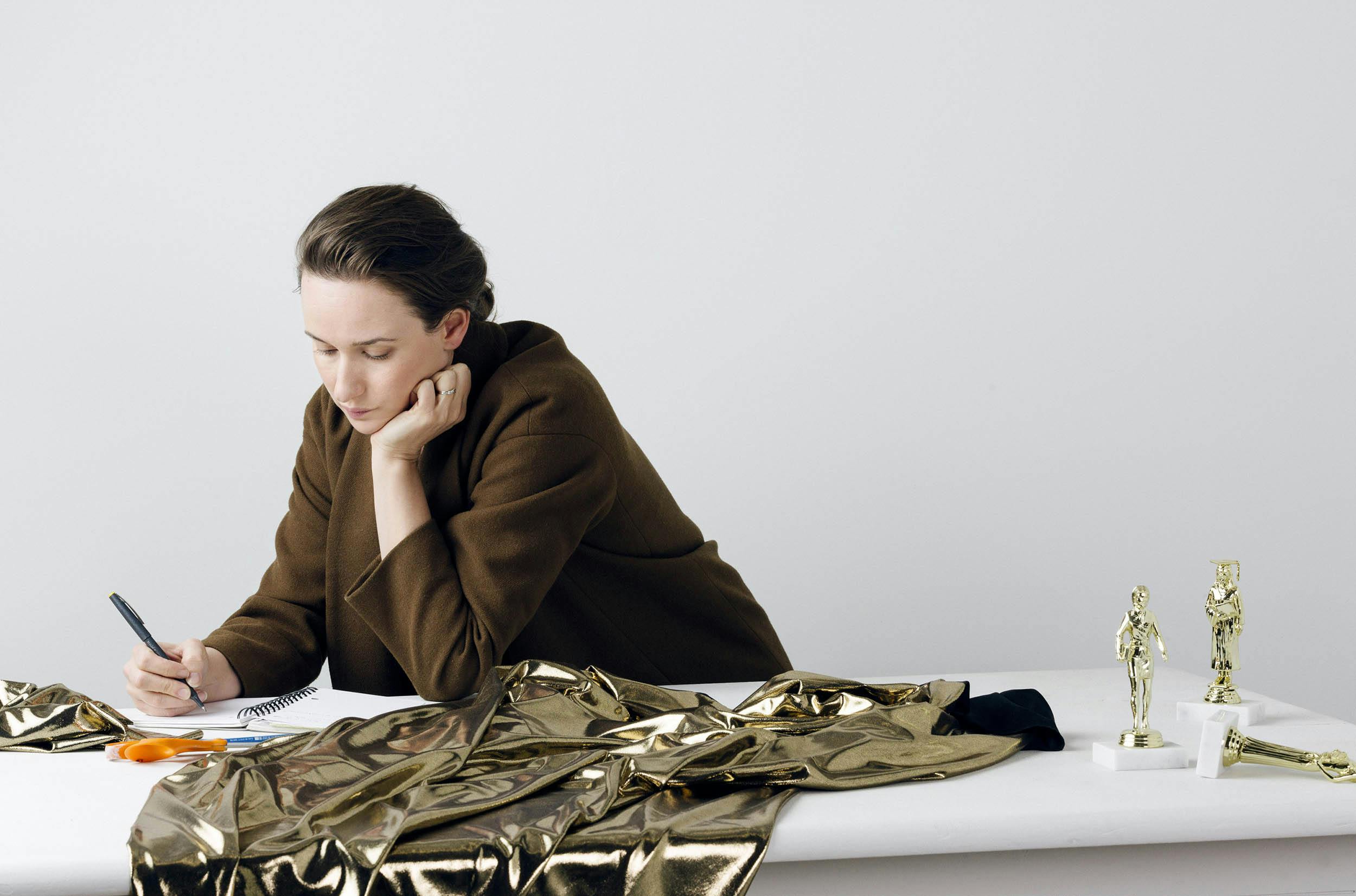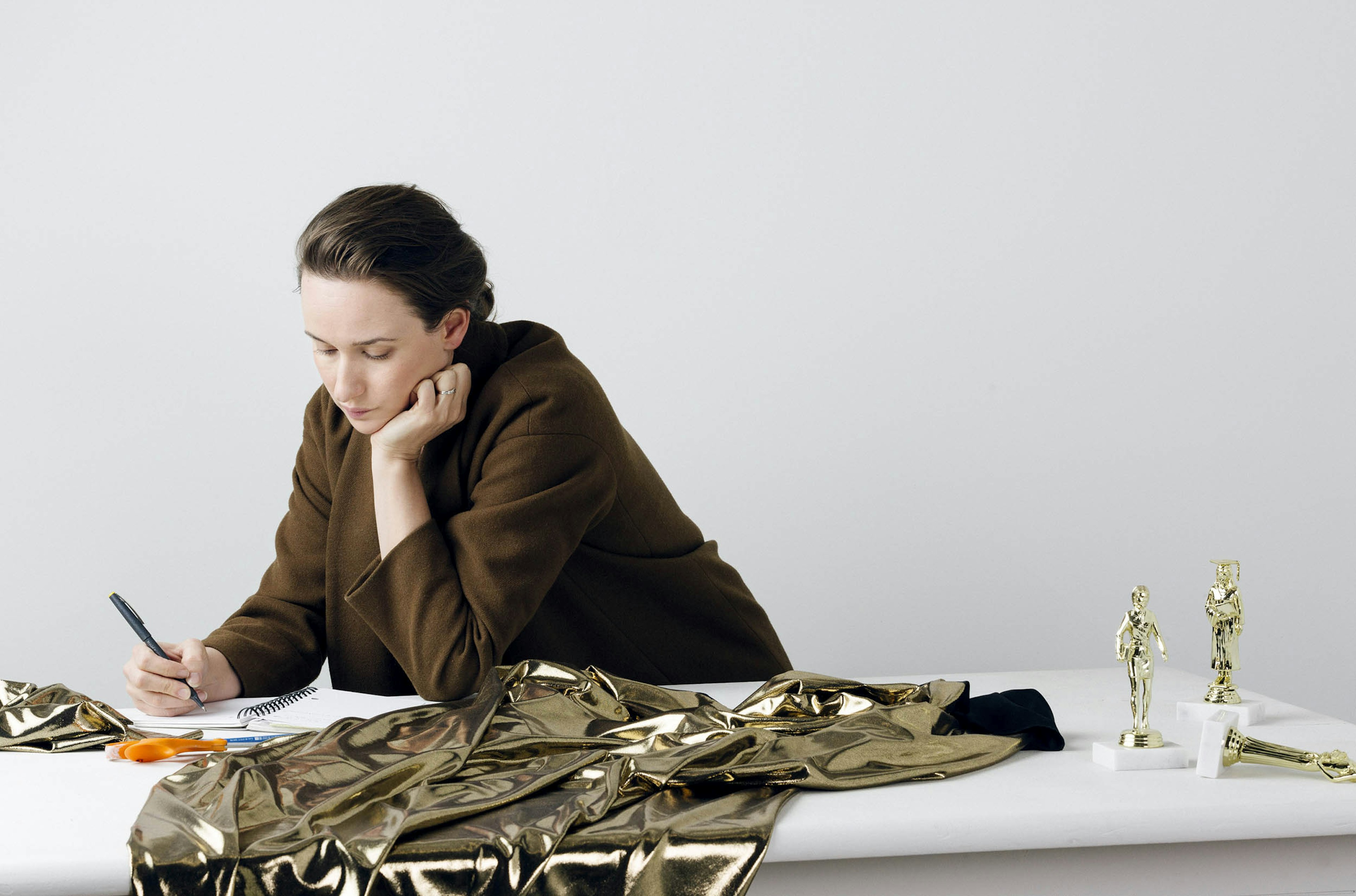“Veiled and Unfurled” an essay by Andrew Berardini on Laura Shill’s


An excerpt by Andrew Berardini originally published in Issue One of WVW.
“Veiled and Unfurled” an essay by Andrew Berardini on Laura Shill’s
*Originally published in Issue one of WVW
The fabric folds and drapes, cinched it flows in straight lines and cascades into loose soft puddles. The curtain closes the stage, protects the magic of the ritual until the ceremony begins. The sumptuousness of the cloth, heavy or thin, natural or synthetic draws an eye like fingers down its slim length. In the exhaust and glare of the textile district, the old shopkeepers and young designers argue over yards in storefronts and arcades stuffed with bolts and bolts of exotic textures and colors, tight weaves and varied thread-counts, each clipped edge rubbed firmly between fingers, again and again, to truly feel a price through its sensuality on their tips.
Behind velveted and crowned little lords in certain old paintings, it’s easy to forget the official subject, the spoilt princeling of a forgotten aristocrat, long moldered under a weathered tombstone, and lose yourself in the curtains that silkily ripple over their shoulder. Your stare holds a beat, then two, then time dissolves into the unreality of this cloth, more real than if it was pressed against your face, a skirt singing against your bare legs, and everything hazes out except those smooth folds, centuries away on a faraway continent from a disappeared civilization, if they ever existed truly outside the mind of the painter and the illusions of this canvas in its gilded frame hanging in front of you.
What curtains, conceals. Brides-to-be veil their faces, an old modesty tradition or some say the moment when hubby gets to claim his property, the privilege of a woman’s face only for him to see. Many a blushing girl has been murdered for the crime of pulling away the veil, simply showing the brazen beauty of her face. In the Dance of the Seven Veils or really any midnight bellydancer’s erotic shimmy, a female body rolls and flounces with and through the silks and organdies, taffetas and polyesters that veil her athletic allure, her movements summoning lechery in even the most sober amongst us. A slow reveal of feminine mysteries to an audience usually (but not always) composed of lusty dudes. The veils are beautiful because they are unveiled, a present unwrapped, but yet still just out of reach like the fruit that tortures Tantalus in Hades, always just in front of his lips but never to be mouthed. Anyone who really understands eroticism will tell you that the heat is in the reveal, the blossoming of a body, a being, and finally a soul, each protective veil pulling away to uncover deeper and richer mysteries than the blunt stupidity of hardlight on simple anatomy or the brute consummation of an animal desire (though with consent, these too can have their place).
Standing in the studio of Laura Shill, the veils, metallic synthetics invented last week here perfectly fold like carved marble over hidden protuberances, maybe basketballs hung just so or pregnant bellies. Their maker calls them “trophies” and that doesn’t foreclose either interpretation A couple of these hang from the wall, unresolved and unresolveable. Unresolved as their maker was working her way through and how they worked, still in composition, ideas and feelings in process of being handled, arranged, decided through materials. Unresolveable because like most good art, it holds at least two, and many more meanings likely yet to be revealed. The more possible ways of seeing that any work can tease out of your eyes, the better. When there are those meanings just beyond our grasp, we call those works “haunting.” They follow us like ghosts, Hamlet’s dad pleading for justice, begging us to resolve their trauma, free them by seeing them as more than mist.
Close by in Laura’s studio, the hundreds of arms of a pink fabricky creature dangle with soft menace and weird enticement, giant pussies like doorways grin with teeth and pendulous breasts bloom in profusion. A fertility goddess to be worshipped, a monster for the patriarchs, the set of a particular vaginal Saturday morning children’s tv show. Fabric gets gendered all the time, mostly because for centuries in many quarters, women were restricted from expressing creativity in little else. Louise Bourgeois’s bulbous bodies, female in their curves, the sisters of the Venus of Willendorf woven and stitched, they celebrated the soft curve. The sensuous allure here has not disappeared in these wildly, tentacular vaginadentatas that Laura’s stitched together, but their color and form, material and abundance make them both fearsomely powerful and physically playful. Visceral subject combines with the fanciful in these soft things and any initial shock dissolves. And like most soft things, you can imagine them against your body, pillows and sofas, a place to let go of weight, too cushiony for anything too angular or driven like work. Something altogether theatrical, but much too corporeal to slump into the pejorative of that term, closer to ritual without feeling leaden with dead tradition.
In a series from a few years back called “Absent Lovers”, Laura took the classic embrace embossed on the covers of romance novels and subtracted everything but a single figure, the man’s arms wrapping around the empty space where his female lover once stood, a woman gripped in some desirous repose, sometimes either their hands or arms remained disembodied behind. The dudes look sweaty and a bit menacing (though sometimes yielding). The ladies often seem bent in some play-action of submission, though one or two seems caught up with the fire of her own desire. The trick is not the seen but the unseen,the invisible body pressed against their leftover lover, what shape did body possessed. When the hands remained, there was a kind of metaphor for desire, those fingers reaching out hungrily letting a body know how exactly attractive it is. A body disappeared in these cut outs is not too different than a body veiled, and both seem elegant allusions to the fierce and corporeal presence of real bodies, the kind playfully engorged into Laura’s fabricky vaginal environments. And though the word “body” has appeared about fifty times above, I wouldn’t even say that bodies are truly the subject even if often the medium. These works seem to explore those forces around bodies, desire and power, mystery and yearning, the geometry and gravity of physical being. As much as veils create a hankering for an unveiling, Laura’s “Trophies” and other veiled objects and bodies don’t ask for that, but hang in almost classical repose telling me that the mystery is in its form, it’s power in a curve never meant to be handled at all. Bodies here are not meant as objects of desire, but subjects of their own shapely force.
About Andrew Berardini
Andrew Berardini. Born in California. Lives and works in Los Angeles. Father of Stella. Writer of quasi-essayistic prose poems about art and other sensual subjects, occasional editor, reluctant curator with past exhibitions at MOCA - Los Angeles, Palais de Tokyo - Paris, and Castello Di Rivoli - Turin. Formerly held curatorial appointments at LAXART and the Armory Center for the Arts and the editorial staff of Semiotext(e). Recent author of Danh Vo: Relics (Mousse, 2015) and currently finishing another book about color. Regular contributor to Artforum, Spike, and ArtReview and an editor at Mousse, Art-Agenda, Momus, and the Art Book Review. Warhol/Creative Capital and 221a Curatorial Grantee. Faculty at the Mountain School of Arts since 2008 and the last three years at the Banff Centre.
